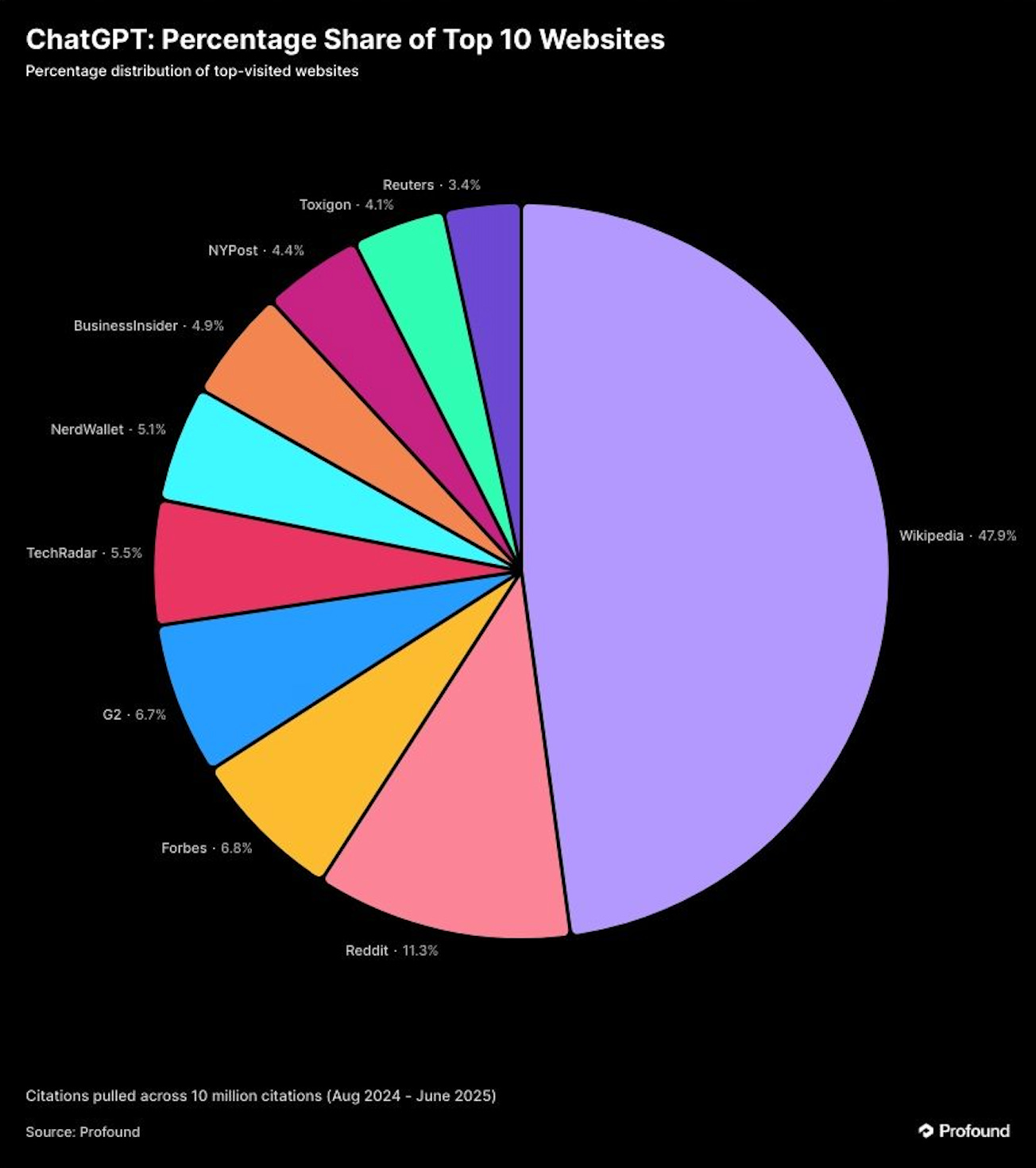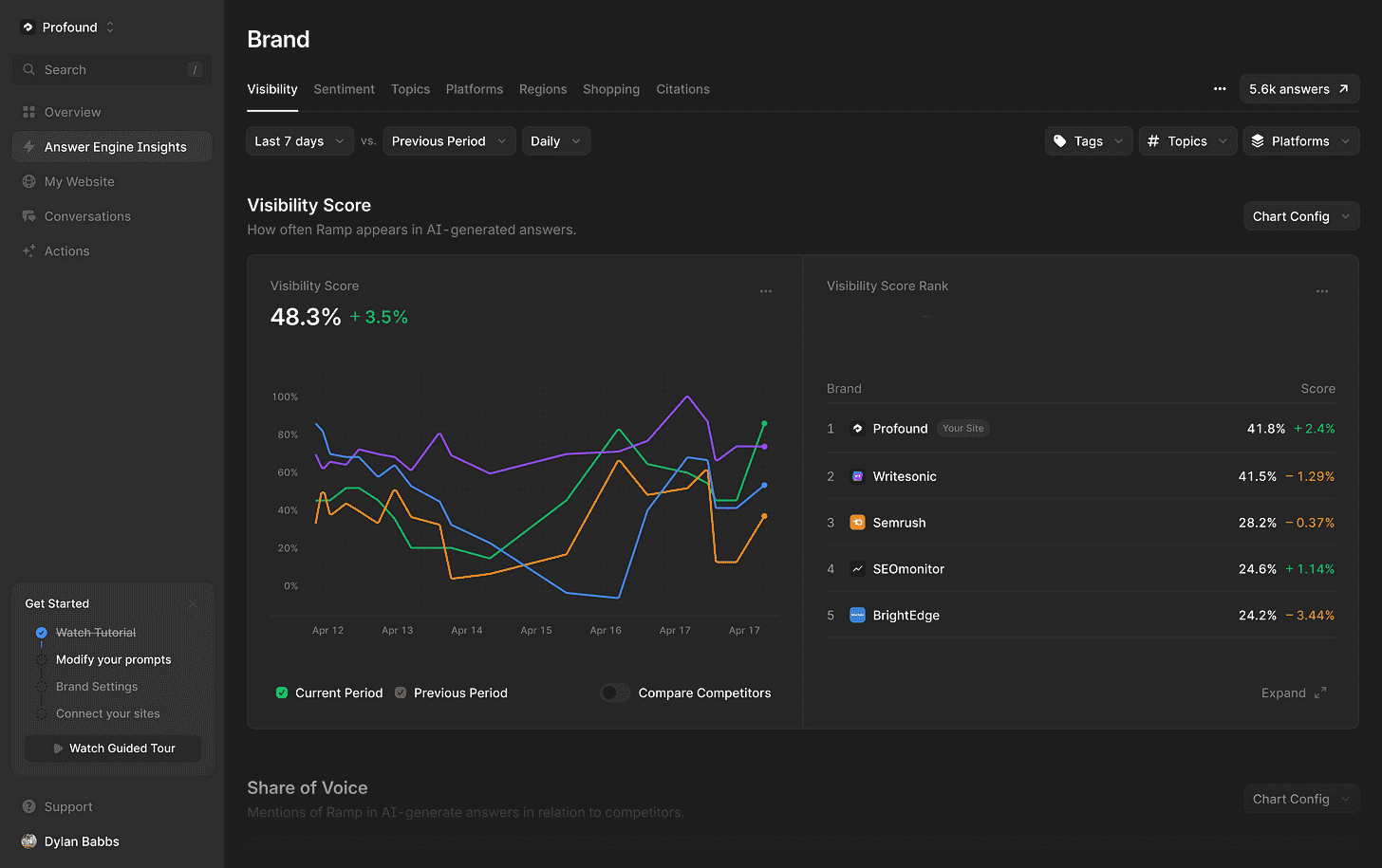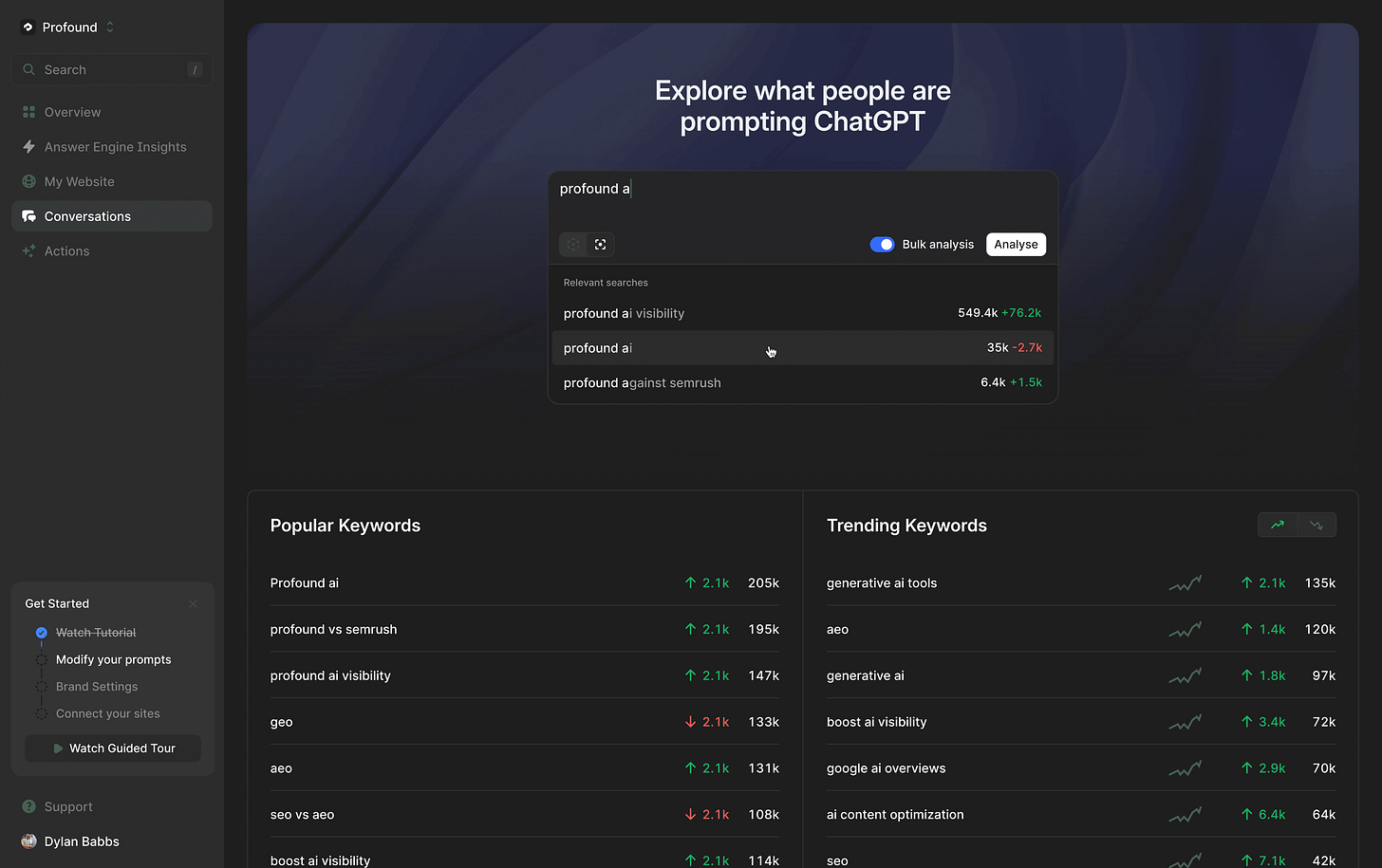SEO Is Tanking. How to Win With AEO / GEO
Deep Dive from Profound's Head of Growth Nick Lafferty
Like many marketers, I’m obsessed with Answer Engine Optimization (AEO) since the rapid decline of SEO effectiveness. I’m even more interested in how marketers within AEO visibility companies are using it themselves (should be best in class, right?) So this week, I dug deep with Nick Lafferty, the Head of Growth at Profound, one of the top platforms in the AI visibility space. How does he create and optimize content to win top ranking in ChatGPT, Claude, Gemini? Watch the interview and deep dive insights below.
Jump to the best parts:
(03:50) → From Keywords to Prompts – long prompts vs short searches, how to collect and track prompts, baselining visibility
12:25 → Affiliate Influence & Industry Nuance – how affiliates take an outsized role in visibility, B2B vs B2C contrasts
15:22 → Content That LLMs Love – comparison pages, alternatives, listicles, off-property publishing strategies
31:00 → Advertising & The Future of AI Search – will LLMs allow ads?, Google’s AI mode, perplexity experiments
Highlights of our conversation and more resources below:
Behind the scenes - Which sites rank high in LLMs?
Wait… what do we call it?
Prompts are much different than keywords
Measuring visibility (Before you try to move it)
Automated tracking in action (Sceenshots!)
Speed matters more than ever (New pages can index in 48 hours!)
The content that moves results
What results look like (so far)
Ads inside LLMs?
A 14-Day AX Playbook (steal this)
Profound’s Answer Engine Optimization Guide
My takeaways for CMOs
Behind the Scenes - Which Sites Rank High in LLMs?
Many of us have seen Nick’s research from earlier this year, sharing how sites previously lower priority for marketers are now driving many top responses:
Wikipedia & Reddit show up constantly. You likely weren’t optimizing for either—now you need a plan. (Wikipedia requires real press/third-party notability; most early-stage companies can’t force it.)
Q&A format and comparisons outperform more traditional thought leadership - this is why Reddit and Forbes, which index content in this way, both show up high as sources.
Paywalls hurt indexing; traditional media that’s strong for comms visibility and authority doesn’t help in LLMs if it's behind sign-in.
Affiliate/listicle ecosystems dominate certain categories (e.g., Wirecutter and mattress reviews). If your category is affiliate-heavy and you’re not in those lists, you can be invisible in AI answers.
While I found this data fascinating, it only underscored my desire to use the platform that customizes the data to my own audiences and terms.
Wait.. what do we call it?
Nick’s team prefers “Agent Experience” over Answer Engine Optimization or Generative Engine Optimization (GEO). Why? Because it’s not just the evolution of SEO - your new primary “visitor” isn’t a human—it’s an AI agent crawling, reading, and synthesizing your content into answers. Design, CTAs, and pretty pixels matter less to bots than structure, clarity, and citations. Your job shifts from “make a great page for people” to “make a great answer for agents.”
Prompts are much different than keywords
Old world: optimize for keywords and clicks
New world: optimize for prompts and citations
Prompts are longer and richer than searches. The average prompt is 20+ words; the average Google query is 3–5. That extra context changes everything: you’re not trying to rank for “best CRM”—you’re trying to be cited in “I’m a 50-person B2B SaaS with a PLG motion and a small SDR team—what CRM should I use and why?”
How to build your prompt set (Step Zero): Before you can measure, you need to create a focus on the right prompts. You can set up a process in two ways:
Add “How did you hear about us?” to forms (if viable, make it open text, accept “ChatGPT/LLM”). Follow up and ask: “What prompt did you use?”
Run an internal “pretend you’re a prospect” exercise with your team. Create a short Google form and ask everyone to pretend like they’re one of your prospects. Ask them to write a prompt looking for a solution like yours.
Pull out common words or themes. Those become your tracked prompts.
Measuring visibility (Before you try to move it)
You can’t improve what you can’t see. While Profound automates this process, Nick suggested that those just getting started could also create a simple Eexcel tracker capturing Prompt (verbatim), Platform (ChatGPT/Perplexity/Claude/Gemini), Top answers (who’s mentioned), Links cited (domains + pages), Is our brand mentioned? (Y/N), and “Visibility Score” (% of prompts where you appear).
Then it’s time to decide your posture:
Offense: You show up in ~20% or less → build net-new content (listicles, Q&A, comparisons).
Defense: You show up in ~80–90% → protect/refresh the specific pages getting cited.
Also: make sure LLM crawlers aren’t blocked. Profound finds Cloudflare and other filters quietly stopping bot access (and your citations) without you realizing it. Crawlers don’t like JavaScript and love plain old text.
Automated tracking in action
In case you’re interested in seeing Profound’s dashboard, here are a few screenshots (I’m not sponsored by them, just ended up on a deep dive based on the interest of my clients). Among the core features of Profound is the visibility score and ranking, customizable over different periods, topics, tags, and platforms:
The platform lets you look through trending prompts.
While ChatGPT is providing the bulk of the traffic to most brands right now, strong AEO programs will optimize across a number of different engines, each potentially with its own nuances.
Speed matters more than ever (New pages can index in 48 hours!)
The biggest misconception Nick hears regularly: “LLMs only use old training data.” Not anymore. ChatGPT (and friends) often live-search for bottom-of-funnel queries and can pick up new pages within ~48 hours. That means velocity is your secret weapon—ship, ship, ship. You might see immediate results.
The content that moves results
From Nick’s experience, if you publish nothing else, publish these:
“Best [Category] tools” listicles
Head-to-head comparisons (e.g., You vs. Competitor A vs. Competitor B)
Vendor alternatives (e.g., “Top SendGrid alternatives”)—Nick’s gold standard is Postmark’s honest alternatives page.
Structured Q&A addressing purchase criteria (pricing, support, integrations, security, who it’s for)
He suggests brands be brave about hosting competitor names on their sites. Prospects already know them—and the agent is going to assemble a comparison anyway. If you don’t supply your POV, it will pull (or hallucinate) someone else’s.
One of Profound’s own secrets to success is really high-quality content on external sites from partners as well - especially for competitor comparisons.
On-site: fastest to publish; you control the message.
Off-site: often more authoritative to LLMs and infinitely more scalable. Build a partner network and syndicate high-quality, balanced pieces at scale (with editorial approval), especially listicles and comparisons.
What results look like (so far)
Profound says ~15% of their leads cite ChatGPT as first touch (self-reported). Vercel’s CEO shared ~10%. of their traffic is coming from LLMs.
Branded search lifts as buyers start in ChatGPT, then Google your name; a third-party study pegged this at ~10% lift in B2C / ~15–17% lift in B2B.
Case studies Nick can share publicly:
Ramp: ~7× AI visibility in a key category
Airbyte: 3× brand visibility in a week
Statsig: jumped from ~22% → ~50% visibility within a week
Early but telling pattern: LLM-referred prospects arrive more educated and convert at higher rates. AI Content and AEO Agency GrowthX reports their customers are seeing 3-5X higher conversion rates on LLM-sourced traffic. Even if raw traffic looks modest, it can create more qualified pipeline.
Ads inside LLMs?
Short version: yes, they’re coming (they already exist in a limited form). Google’s AI mode is monetized; Perplexity experimented; OpenAI will feel pressure to add formats over time, though Sam Altman seems hesitant. Don’t bet your 2025 on LLM ads, but watch the space closely.
A 14-Day AX Playbook (steal this)
Day 1–2: Instrumentation
Add “How did you hear about us?” (open text).
Stand up your AX Visibility Log (sheet or tool).
Confirm LLM crawlers aren’t being blocked.
Day 3–5: Prompt discovery
Email recent leads who cited LLMs → ask for their exact prompts.
Run the internal prompt drive (Google Form). Cluster themes.
Day 6–8: Foundation content
Publish 1–2 “Best [Category]” listicles.
Publish 2–3 comparisons (you vs. top rivals).
Convert FAQs into scannable Q&A pages (one question per page, schema if you have it).
Day 9–12: Off-site syndication
Identify relevant partner/affiliate/editorial sites.
Pitch balanced listicles and an alternative piece; fund freelance quality if needed.
Day 13–14: Daily cadence + refresh
Log visibility across top prompts daily.
Update pages cited by LLMs (fresh data, clearer tables, pricing, who it’s for).
Expand to adjacent prompts weekly.
→ Profound’s Answer Engine Optimization Guide
Want even more? Profound is just about to publish this detailed “Answer Engine Optimization Guide” — download it here first : )
My takeaways for CMOs
Agent Experience is not a side quest. It’s coming for us quickly.
Velocity > perfection. LLMs can cite new content in ~48 hours. Ship fast.
Comparisons win. If you don’t write them, someone else will—and the agent will trust them.
Off-site scale matters. Syndication networks work.
Measure reality. Can’t improve what you can’t track
Are you seeing traction with your AEO and GEO efforts? Would love to hear your real-world stories.
Carilu Dietrich is a former CMO, most notably the head of marketing who took Atlassian public. She currently advises CEOs and CMOs of high-growth tech companies. Carilu helps leaders operationalize the chaos of scale, see around corners, and improve marketing and company performance.






wow, well—as the author of that Postmark 'gold standard' listicle, I am both surprised and happy to show up in your newsletter, Carilu! 😉